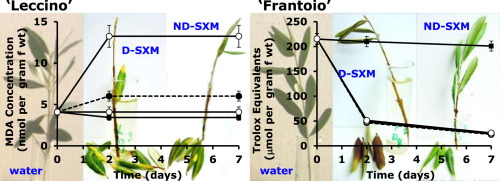当前位置:
X-MOL 学术
›
Plant Physiol. Biochem.
›
论文详情
Our official English website, www.x-mol.net, welcomes your
feedback! (Note: you will need to create a separate account there.)
Physiological response of two olive cultivars to secondary metabolites of Verticillium dahliae Kleb.
Plant Physiology and Biochemistry ( IF 6.1 ) Pub Date : 2020-03-26 , DOI: 10.1016/j.plaphy.2020.03.029 Giovanni L Bruno 1 , Samer Sermani 1 , Mariangela Triozzi 2 , Franca Tommasi 2
Plant Physiology and Biochemistry ( IF 6.1 ) Pub Date : 2020-03-26 , DOI: 10.1016/j.plaphy.2020.03.029 Giovanni L Bruno 1 , Samer Sermani 1 , Mariangela Triozzi 2 , Franca Tommasi 2
Affiliation

|
The effects of two purified fractions (formerly D-SXM and ND-SXM) produced in vitro by defoliating (Vd312D) and non-defoliating (Vd315ND) strains of Verticillium dahliae were studied on twigs of Olea europaea cvs Frantoio and Leccino. Symptoms, such as leaf curling, yellowing, vein clearing and defoliation, which are observed on the two cultivars naturally affected by Verticillium wilt, were produced by these fractions. Physiological changes were induced during the first seven days after the absorption of solutions containing ND-SXM or D-SXM. Both fractions increased the transpiration flow from abaxial leaf surfaces. Cell membrane and antioxidant activity were the most important action sites of ND-SXM and D-SXM. ND-SXM influenced malondialdehyde concentration in 'Leccino' leaves, while D-SXM increased the percentage of electrolyte leakage in 'Frantoio'. Both fractions reduced the total non-enzymatic antioxidant activity on the leaves of the treated twigs. The total phenol content increased in both cultivars, without differences to the control. Variations on electrolyte leakage and total antioxidant activity were effective in discriminating the two tested olive cultivars for V. dahliae tolerance or susceptibility. If V. dahliae strains Vd315ND and Vd312D produce ND-SXM and D-SXM in the infected plants, these metabolites may move via the xylem sap, accumulate in the leaves and induce changes that will lead symptoms on the leaf by compromising the cell membranes physiology.
中文翻译:

两个橄榄品种对黄萎病菌次生代谢产物的生理响应。
在油橄榄(Olea europaea cvs Frantoio和Leccino)的细枝上研究了黄萎病菌(Verticillium dahliae)的脱叶(Vd312D)和非脱叶(Vd315ND)菌株体外产生的两个纯化级分(以前称为D-SXM和ND-SXM)的作用。这些组分产生了在自然受到黄萎病影响的两个品种上观察到的症状,如叶片卷曲,泛黄,叶脉疏通和脱叶。在吸收含有ND-SXM或D-SXM的溶液后的前7天,诱导了生理变化。这两个部分都增加了从背面叶表面蒸腾的水。细胞膜和抗氧化活性是ND-SXM和D-SXM最重要的作用部位。ND-SXM影响了'Leccino'叶片中丙二醛的浓度,而D-SXM增加了“ Frantoio”中电解液泄漏的百分比。两种级分均降低了处理过的嫩枝叶上的总非酶抗氧化活性。两个品种的总酚含量均增加,与对照无差异。电解质泄漏和总抗氧化剂活性的变化可有效区分两个测试的橄榄品种对大丽花的耐受性或敏感性。如果大丽弧菌菌株Vd315ND和Vd312D在受感染的植物中产生ND-SXM和D-SXM,这些代谢物可能会通过木质部汁液移动,在叶片中积累并诱导变化,从而通过损害细胞膜生理而导致叶片症状。 。两个品种的总酚含量均增加,与对照无差异。电解质泄漏和总抗氧化剂活性的变化可有效区分两个测试的橄榄品种对大丽花的耐受性或敏感性。如果大丽弧菌菌株Vd315ND和Vd312D在受感染的植物中产生ND-SXM和D-SXM,这些代谢物可能会通过木质部汁液移动,在叶片中积累并诱导变化,从而通过损害细胞膜生理而导致叶片症状。 。两个品种的总酚含量均增加,与对照无差异。电解质泄漏和总抗氧化剂活性的变化可有效区分两个测试的橄榄品种对大丽花的耐受性或敏感性。如果V. dahliae菌株Vd315ND和Vd312D在受感染的植物中产生ND-SXM和D-SXM,这些代谢物可能会通过木质部汁液移动,在叶片中积累并诱导变化,从而通过损害细胞膜生理而导致叶片症状。 。
更新日期:2020-03-27
中文翻译:

两个橄榄品种对黄萎病菌次生代谢产物的生理响应。
在油橄榄(Olea europaea cvs Frantoio和Leccino)的细枝上研究了黄萎病菌(Verticillium dahliae)的脱叶(Vd312D)和非脱叶(Vd315ND)菌株体外产生的两个纯化级分(以前称为D-SXM和ND-SXM)的作用。这些组分产生了在自然受到黄萎病影响的两个品种上观察到的症状,如叶片卷曲,泛黄,叶脉疏通和脱叶。在吸收含有ND-SXM或D-SXM的溶液后的前7天,诱导了生理变化。这两个部分都增加了从背面叶表面蒸腾的水。细胞膜和抗氧化活性是ND-SXM和D-SXM最重要的作用部位。ND-SXM影响了'Leccino'叶片中丙二醛的浓度,而D-SXM增加了“ Frantoio”中电解液泄漏的百分比。两种级分均降低了处理过的嫩枝叶上的总非酶抗氧化活性。两个品种的总酚含量均增加,与对照无差异。电解质泄漏和总抗氧化剂活性的变化可有效区分两个测试的橄榄品种对大丽花的耐受性或敏感性。如果大丽弧菌菌株Vd315ND和Vd312D在受感染的植物中产生ND-SXM和D-SXM,这些代谢物可能会通过木质部汁液移动,在叶片中积累并诱导变化,从而通过损害细胞膜生理而导致叶片症状。 。两个品种的总酚含量均增加,与对照无差异。电解质泄漏和总抗氧化剂活性的变化可有效区分两个测试的橄榄品种对大丽花的耐受性或敏感性。如果大丽弧菌菌株Vd315ND和Vd312D在受感染的植物中产生ND-SXM和D-SXM,这些代谢物可能会通过木质部汁液移动,在叶片中积累并诱导变化,从而通过损害细胞膜生理而导致叶片症状。 。两个品种的总酚含量均增加,与对照无差异。电解质泄漏和总抗氧化剂活性的变化可有效区分两个测试的橄榄品种对大丽花的耐受性或敏感性。如果V. dahliae菌株Vd315ND和Vd312D在受感染的植物中产生ND-SXM和D-SXM,这些代谢物可能会通过木质部汁液移动,在叶片中积累并诱导变化,从而通过损害细胞膜生理而导致叶片症状。 。











































 京公网安备 11010802027423号
京公网安备 11010802027423号